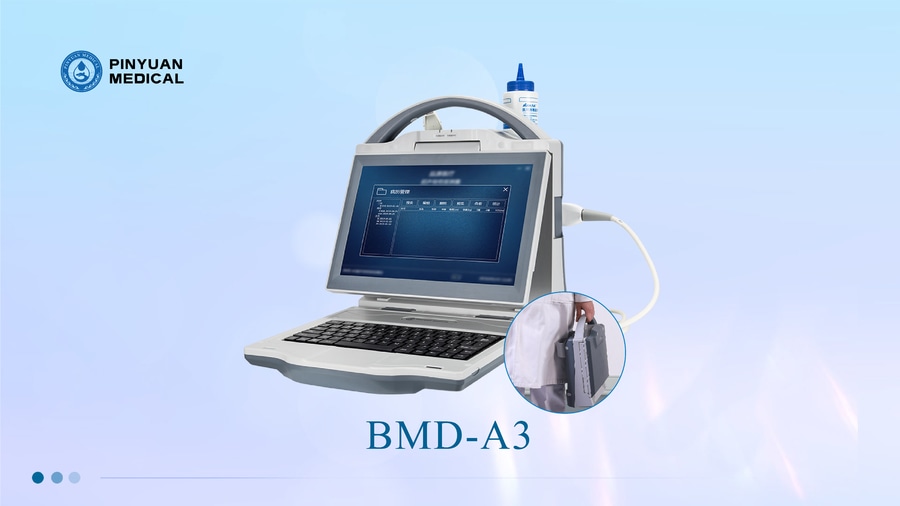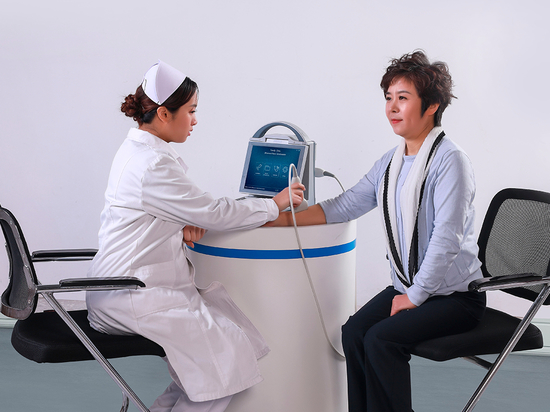
#Product Trends
Precise measurement of bone density - Ultrasonic bone density detector
Ultrasonic bone density detector is convenient to detect, no radiation damage, can be widely used in all ages, especially children, pregnant women and middle-aged and elderly people census, review and so on.
Bone density detector is a special instrument for the detection of bone density, bone density, full name of "bone mineral density". Bone mineral density (BMD) is an important indicator of bone quality, reflecting the degree of osteoporosis and predicting the risk of fracture.
It is an instrument that uses ultrasound to measure SOS (ultrasonic sound velocity), BUA (ultrasonic frequency attenuation) and BQI (bone index) of human calcaneum and other parameters related to bone quality through the measured tissue through water or coupling agent, and calculates and reflects the value of human bone mass, so as to diagnose the bone condition of the tested person, and is non-invasive, non-destructive and non-radiation.
The importance of ultrasound bone mineral density measurement
Ultrasound bone mineral density detector has great reference value and guiding value for the physiological development of children and the prevention of bone damage and fracture risk in the elderly, and provides an advanced diagnostic means for osteoporosis disease. With the rapid increase of the elderly population, osteoporosis has become a serious public health problem. Osteoporosis is a common and frequently occurring disease in middle-aged and elderly people, known as the "invisible killer", which is not easy to be detected. It is not early when there is back pain, height reduction and hunchback. Some patients even have fractures before they seek medical treatment, which seriously endangers the health of middle-aged and elderly people. The incidence of secondary osteoporosis is also increasing, so accurate bone mineral density detection is very necessary, middle-aged and elderly people at least once a year for bone mineral density detection. For developing children, bone mineral density can reflect the development and calcification of bones, and can be used in the detection, auxiliary diagnosis, etiology analysis and treatment observation of the following nutritional deficiencies and diseases in children. These include calcium deficiency, vitamin D/K/C/A deficiency, zinc deficiency, precocious puberty, delayed sexual development, lead, cadmium and VD poisoning, and growth hormone (GH) deficiency. These diseases and unhealthy conditions can cause abnormal bone development and bone mineral deficiency, which can lead to rickets in severe cases. It can be detected early by bone density examination, and the cause can be analyzed by follow-up observation after treatment to improve the preventive treatment effect.
Which populations are suitable for bone mineral density detection
1. Children and adolescents:
Childhood bone development is the basis of adult bone, and insufficient accumulation of bone density will directly lead to adult osteoporosis. Children with the following factors should be wary of low bone mineral density: insufficient calcium, VD intake, family history of osteoporosis, obesity, preterm birth, adolescence, steroid use, children with growth delays, physical inactivity, etc.
2. Pregnant women and nursing mothers:
The reserve of bone calcium in preconception and pregnant women is crucial to the healthy development of the fetus. Understanding the status of bone during pregnancy and good health care during pregnancy can effectively prevent pregnancy complications (osteoporosis and hypertension). Bone calcium loss is faster during lactation, when bone mineral density is low, it can lead to the decrease of bone calcium in nursing mothers and infants.
3. Postmenopausal women
After the age of 50, most women will enter menopause. After menopause, estrogen secretion levels will decline, bone mass will also be lost, and intestinal calcium absorption function will decline, and vitamin D synthesis will not be enough after the reduction of sunlight, which further causes osteoporosis.
4.Elderly people over 60 years old
Suffering from diseases that affect bone mineral metabolism, or taking drugs that may affect bone mineral metabolism, will increase the chance of osteoporosis in the elderly, resulting in numbness, neurasthenia, arteriosclerosis, coronary heart disease, diabetes and other age-related diseases. Regular bone density examination can timely understand bone strength and the content of calcium in the body, and timely intervention can effectively reduce other diseases caused by osteoporosis.
Ultrasonic bone density detector is convenient to detect, no radiation damage, can be widely used in all ages, especially children, pregnant women and middle-aged and elderly people census, review and so on. It can observe the changes of bone density in a safe and non-invasive manner, and predict the development status of bone and the risk of complications in time.
Osteoporosis is a disease that develops with age and is characterized by a range of bone density. Osteoporosis, which has low and weak bones and popliteal bones and is therefore prone to fractures, can be triggered by the elderly and women. The incidence of osteoporosis caused by menstrual and endocrine diseases is 50% in people over 50 years of age. Make it easy to fracture, see is the femoral neck, spine and radioulna of the three parts of osteoporosis rarely have conscious symptoms, and is not easy to be early detection, so it is recommended that the above population should do at least once a year bone density screening, understand their bone condition.






